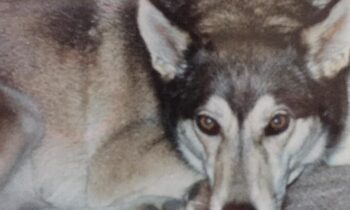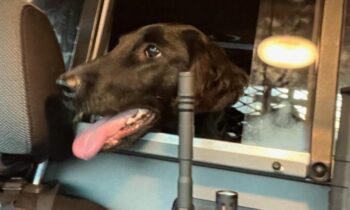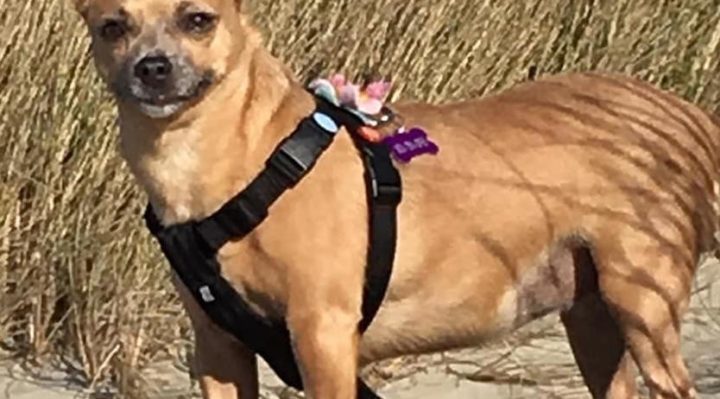
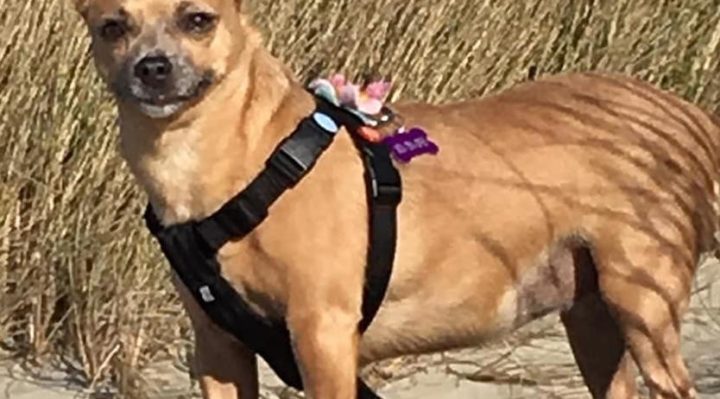
Last week, I embarrassed my own dog by talking about how he’d gained too many pandemic pounds. I accepted full accountability, both for his weight gain and for making sure he lost those pounds. He’s my responsibility. I’d already done him wrong. I want to do his diet right.
This week, I asked dog professionals for their advice about how to help a dog reach a reasonable weight-loss goal without reducing the dog’s engagement and enthusiasm. Here are some of their suggestions.
Colette Kase (Mexico), puppy trainer, retired behaviorist. I just give them a little less food until they look good. Nothing magical or requiring maths. I reduce their daily portions by a small amount.
Linda Ehrenworth (New Jersey), certified dog trainer. A simple way is to just slightly reduce your dog’s daily calorie intake. Example: If your dog normally eats 4 cups of food daily, reduce to 3 and 3/4 cups a day. Always check with your vet before reducing a dog’s calories.
David Bozak (New York), U.S. Dog Agility Association (USDAA) masters judge. Cut some kibble and add pumpkin and/or green beans. Adds fiber and bulk and not calories. Weigh the dog weekly and adjust kibble appropriately. Also, we use animal crackers for treats—low in fat, low in calories, VERY kidney friendly (if you have a dog with renal woes). And you can snack on them, too! The dogs LOVE animal crackers. Plus they are really inexpensive—USD$2 to $3 for a two-pound bag.
Jane Finneran (North Carolina) I have also had results with the “green bean” diet. Love the idea of animal crackers.
David Bozak (New York) Mini-marshmallows are kidney friendly . . . and they are REALLY desirable!
Deborah Watson (Nevada) canine nutritionist, canine nutrition educator. Animal crackers and marshmallows are not appropriate snacks, especially for weight loss. Marshmallows are pure sugar. Animal crackers are wheat and sugar. These are not biologically appropriate foods for a dog on any level. More appropriate options are freeze-dried meats and seafood (chicken breast, turkey breast, liver, salmon, minnows, etc.), bites of apple, baby carrots, or cheese—always in moderation, as in just a few treats on any given day.
David Bozak (New York) Sorry, but I disagree. As you say, a few treats on any day means a couple of animal crackers. No weight issue there. Trim dog nails? One mini-marshmallow per paw. We’ve dealt with renal dogs for decades and yep, the kidney folks agree about these treats. And yep, our dogs also like carrots, apple, sweet peppers. Cheese is a non-starter for us once a dog develops gastrointestinal issues.
George Guba (New York) Feed separately from other pets. Treats are calories, too. Portion control!!!
Beth Fabel (Washington), dog trainer. Use an actual measuring cup or a scale. Look at how and when they get treats and what you are using for treats, and substitute something smaller/lower in calories, or use part of their meal instead. Watch for them finding food you don’t know they are eating, like cat food or chicken feed.
Steven Cogswell (Colorado), canine massage provider. It’s vital to do the math for calories. You should know your dog’s basic Resting Energy Requirement (RER) based on their weight. Then, depending on their situation, calculate their Daily Energy Requirement. A neutered adult with average activity levels who is not prone to weight gain should get 1.6 x RER a day. For weight loss, the dog should get 1 x RER, then 1.4 x RER for maintenance. This is just a ballpark to start; keep an eye on the dog over time to fine-tune. Do the math for the calories in the actual food, not just the recommended feeding on the label. Every label will list how many calories by weight or measurement (usually per cup). If you use treats, they have to be counted in the total daily caloric intake. Then measure, measure, measure! Every time. No eyeballing it.
Lauren Fetterman (California), dog walker in the San Francisco Bay Area. Portion control and learning what a healthy weight looks like (this is assuming that the dog is under regular vet care and current on blood work). If the dog is heavy, reduce calories. If it gets a little too skinny, add calories.
Steven Cogswell (Colorado) YES! Body Condition Score is vital! Most of us don’t know what a dog with a healthy weight should even look like.
Alisha Ardiana (California), dog trainer with a Papillon that needs to lose a pound. She’s a training machine!!!
▪ Calculate your daily calories. https://petnutritionalliance.org/
▪ Measure out the food and treats in the morning. We keep a scale on the counter.
▪ Cat treats are a great taste with fewer calories!
Rachel Bean (United Kingdom), qualified veterinary nurse. Fresh food. Don’t reduce food dramatically. ‘Hangry’ dogs can experience an aggression trigger.
Deborah Watson (Nevada), canine nutritionist, canine nutrition educator. Beautifully said! The beauty of fresh food is that you can compose and balance a meal tailored to a specific animal that reduces caloric intake without reducing volume that would leave you with a hungry animal prone to the same mood changes that humans experience under the same conditions. Having complete autonomy over ingredients allows you to choose lean meats, nutrient-dense organs, raw meaty bones, fruits, vegetables, seeds, and other nutrient-whole foods that meet and exceed all dietary needs for that individual animal . . . without loading up on excess calories or unnecessary fat (yet providing enough necessary fats for optimal health) The advantages here, beyond not having a hungry dog on your hands, are:
▪ Knowing that all essential nutrient needs aren’t just met but exceeded. With kibble/ canned food, reducing food volume often also reduces nutrient intake and many processed foods meet only basic minimums to begin with.
▪ Enhancing the efficacy of the diet beyond basic nutrition with “nutraceuticals” (functional foods that provide both health benefits to reduce the risk of chronic diseases and provide essential nutrition) and foods that support metabolic function
▪ Increasing bioavailability and sharply reducing non-species–appropriate starchy carbs supports ideal metabolic function, a healthy gut microbiome, improved immune health, and natural loss of excess weight because unneeded (and unnatural) carbohydrates aren’t stored as fat.
▪ Increased energy fosters higher activity levels, and higher activity levels burn calories. The caveat here is that pet parents must take advantage of these higher activity levels and give their dog something to do with them! Go for walks, grab a Chuckit and play fetch until Fido is fetched out. Go for a hike. Use That Energy Up!
I see a lot of suggestions to raw feed and that’s AWESOME! Raw feeding can certainly help a dog reach ideal physical condition, but raw feeding must be done correctly to not only be effective but also to be safe.
The link below is loaded with information on how to provide your dog a healthy, species-appropriate fresh-food diet balanced to National Research Council (NRC) guidelines. The page is not so much another chat-focused group as it is an education and resource group with links, articles, tools, raw-meal examples, charts, infographics, veterinary support and scientific research articles, a video library, and more—and yes, even a topic devoted to tackling pet obesity! (The entire page is organized into topics for ease of finding what you’re looking for and to help reduce the information overload we all experience when first looking into raw feeding. When reading by topic, you see only the info tagged to the topic you’re browsing.) If you’d like to join the page, be sure to answer the questions in the member application or the application will be denied. Hope this helps someone.
https://www.facebook.com/groups/637581483756412
Amy Suggars (Ohio), owner of Pet Nannies. I was recently told that my dog should lose a few pounds. (You can say what you want about me, but don’t call my dog fat!) I did the usual things—reduced her regular amount of food and supplemented it with green beans—but I believe the most effective thing I did was switch out dog cookies for baby carrots. Every time I leave the house, I give my dog a treat . . . a Milk-Bone or similar cookie. I didn’t realize how many cookies she was getting every day! The pounds came off easily after I switched to carrots. Katydid doesn’t mind the change. She really likes the carrots!
September B. Morn (Washington), professional dog trainer. Cut back on their daily intake by about 20% to 25%, and be SURE they don’t have a secret food source! I discovered my Sheltie and one of my Rottweilers had been free-snacking on the high-quality kibble through a hole in the bag that a mouse had made where I couldn’t see it. I stopped leaving the kibble in its bag and started putting it in a mouse-proof and free-snacking-dog–proof container. And NOW my two opportunistic foodies are finally starting to trim down.
Clair Eccles (United Kingdom), runs a dog hotel. I reduce their food gradually but substantially. If dogs like veggies, I bulk out a bit with that. From a satisfaction point of view, so they don’t feel deprived, I make their food more enriching by varying how it’s given. May be scattered, hidden and they go seek, etc., spread out through the day.
Jill Gibbs (Montana), owner of Jillcookies. Dock diving! Okay, swimming if possible. I have also replaced a portion of food with canned pumpkin and green beans or Izzy’s fave, snap peas. Snap peas for snacks, every single time the fridge opens. If the weight doesn’t drop with changes, a thyroid panel might be necessary to rule out thyroid issues.
Sandie Hanlon (Massachusetts) Agility and conformation. One easy trick to cut back on over-feeding is to use a food scale. I weigh out my dog’s kibble for the day and use it for feeding as well as training. This way you don’t eyeball it, but have an accurate amount each day.
Jenny Julian (Oregon), owns a dog rescue. I feed overweight dogs raw food. The weight slides off them and they don’t feel hungry. Also: activity! I received a chihuahua mix that was obese at almost 20 pounds. She gained it all in a foster home on low-quality kibble and no exercise. I was able to take 2.5 pounds off before adoption, and continued to pay for her raw food for several months post adoption. She now weighs 12 pounds.
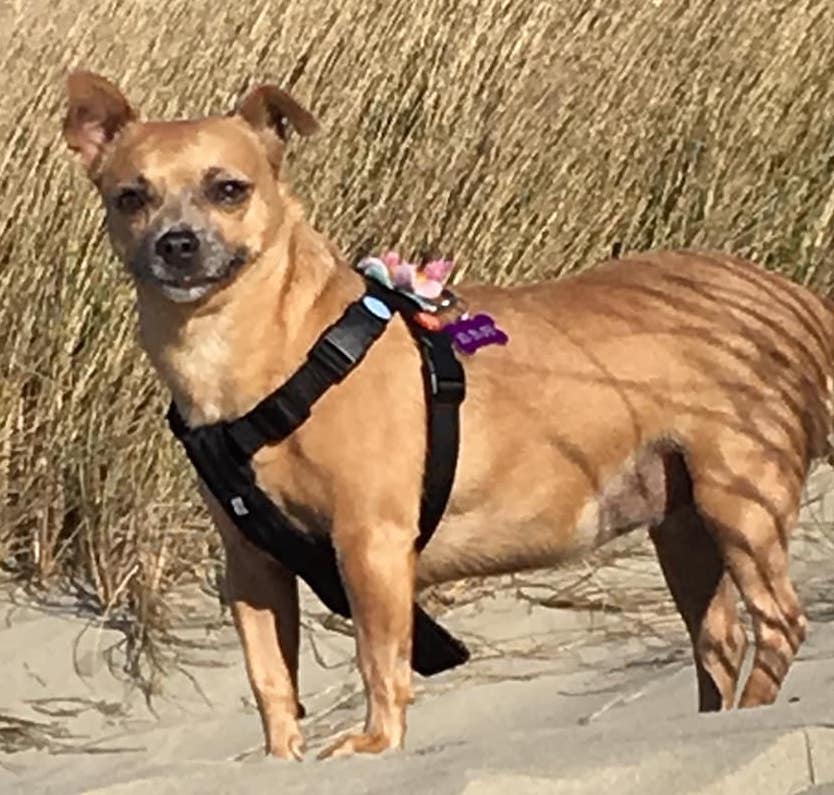
Photo by Jenny Julian
Trish Ryan (New Jersey), professional trainer. After my favorite vet said that [my dog] looks like a loaf of bread—LOL—I cut back on kibble, added a little raw, some veggies, and used kibble for training versus high-calorie treats.
Julie Ellingson (California), groomer. My mother loves to give out treats (this is where everyone fails to moderate), so she measures out the daily ration with a measuring cup in the morning, feeds 1/3 for breakfast, and doles out the dog’s treat ration from the leftovers through the day. Anything left is dinner. She’s kept her cockers at a perfect weight that way. (My father weighs his dog’s meals. No treats allowed.) I recommend that my customers reduce food by 1/4 or feed at the low end of the dog food’s recommended ration for what the dog is supposed to weigh. That’s always a good start. But I think my mom has a good system.
Micha Michlewicz (Maryland) Talk to your vet to rule out any underlying medical components, like arthritis, hypothyroidism, etc., and to figure out how much the dog should actually be eating based on their individual needs.
▪ Green beans to cut calories and fat, but still to help them feel full
▪ Dog food that is formulated for weight management—or, in a pinch, senior diets, which also help
▪ I recommend and use only WSAVA-approved foods [the World Small Animal Veterinary Association] because these are the only companies that have invested some of their profit back into board-certified American College for Veterinary Nutritionist formulations and food trials for proof of concept and claims.
▪ Low-impact exercise can help to burn calories and make the dog feel better. Enrichment (like foraging toys) can be a part of it.
▪ Don’t be afraid of physical therapy for a safe and effective exercise plan.
Christine Caplan (Washington), writer and certified vet tech. Put your dog’s meals in a bowl at the beginning of the day, measured out with a measuring cup. Then, in another bowl, measure out the treats they can have. Then the entire family can dip only into either one of those bowls to treat the dog throughout the day. Once the bowls are empty that’s it—game over for the day. Maybe the meal food gets used for treats; it doesn’t matter, as long as nothing else is given. This works best with kibble (LOL); I haven’t had to measure out raw diets for my dogs that need to lose weight . . .
Jamie Wilke (Washington), groomer. Green beans!
Anna Abney (North Carolina) Feed less, move more! Leashed walks are rarely rigorous enough to provide actual calorie-burning exercise for a dog, but you can boost walks by adding a properly fitted backpack and by slowly conditioning the dog to carry a bit of weight.
Timothy Page (Oregon) Flyball and nosework. I had been feeding Coco once a day . . . perhaps a bit too much, according to our flyball captain. So I reduced it. But Coco insists he is hungry ALL the time. So he gets fed twice a day. His breakfast is a bowl of vegetables (broccoli, cauliflower, two kinds of carrots). He loves it. In the late afternoon, he gets his regular dog food. Treats on his walk for bringing the ball back and for his recall. In the evening, he gets a chew. We call it a “bone,” but it’s just something hard and slow to get down. He came from just under 17 pounds to 14.5 pounds over several months. Flyball captain is now happy. Lalo has never been a problem because he is extremely picky and has to be encouraged to eat. He never gains weight, but he likes the a.m. veggies if you put a little bone broth on them. He won’t touch the carrots, but he loves raw cabbage.
Paula Shimko (Pennsylvania) I cut the kibble and add frozen green beans and pumpkin.
Beverley McKee (Canada) My dog was highly reactive and demonstrated some concerning redirected aggression during high-arousal moments, so my behavior modification plan involved the use of very high-value food. He’s now mostly quite calm and non-stressed around triggers, but he did gain significant weight over the last year. I consulted with my vet, ran a thyroid panel just in case, and put him on a high satiation food and a set number of calories per day.
I’m pretty adamant about consulting with a medical professional prior to switching up diets. I want reassurance that nothing I introduce to my dog’s diet could potentially trigger an underlying issue I may not have considered (i.e., the vet-suggested thyroid panel prior to implementing a weight loss plan).
Amy Fumetti (Washington), dog hotel owner. Replace treats with fruits and veggies. A negative-calorie snack is a way to keep dogs feeling full while shedding some pounds.
Jessa Lewis (Washington) Portion control. Carrots are the go-to dog treat. The crunchy carrots help with tartar, too.
Lore Haug (Texas), Texas Veterinary Behavior Services. Feed less food.
Lori Leah Monet DVM (Colorado) Agree. Only one sure way. Decrease calories, increase exercise, and tell grandpa to quit sneaking food to the dog . . . he’s not in prison.


